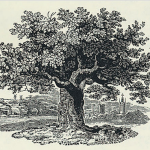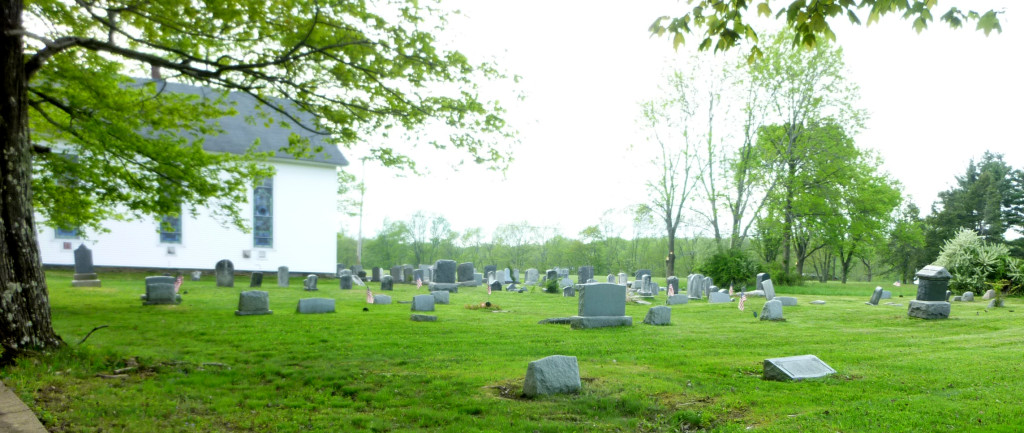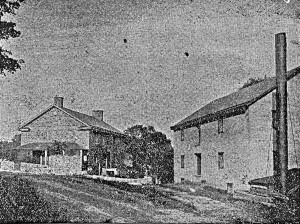This article by Egbert T. Bush concerns a family who lived in the Croton neighborhood in the mid-19th century. I thought it typical of Mr. Bush’s style of writing, which may seem a bit florid, but is full of empathy for the characters he described.
Carrell
CARRELL. This family first appeared in Hunterdon County in the early 19th century when Daniel Carrell bought land in Delaware Township and married Elizabeth Arnwine, whose family dates back here to her Dutch great-grandfather Jacob Arnwine. The Carrells lived in and around Headquarters.
Between Sergeantsville & Sand Brook
part seven, Route Not Taken
The train continues on its way to Sand Brook. Having passed through the southern side of the Village of Sergeantsville, it now proceeds through the properties of James Carrell, Othniel Fauss, William Aller, Acker Moore and Mrs. Sergeant.
The Two Farms of Gideon Moore
My most recent article was the first part of a history of the owners of adjacent farms surrounding the old Hart-Taylor Cemetery. Part One ended with the person who owned both farms, Gideon Moore, Sr., who died in 1840, after bequeathing his two farms separately to two of his sons, William H. Moore and Jacob D. Moore.
The Carrell Family Tree

The Carrell family of Hunterdon County begins with Daniel Carrell and Elizabeth Arnwine. Daniel was the son of James & Sarah Carrell of Tinicum, Bucks County, Pennsylvania. He was born there, but in 1809 he settled on land in Delaware Township, the same year that he married Elizabeth Arnwine, when he was in his 40s. For more information on the Carrells of Bucks County, see Ezra Patterson Carrell, The Descendants of James Carrell and Sarah Dungan, his wife, Hatboro, PA, 1928.
“Copperheadism” in Locktown
During the Civil War, Republicans called Democrats who opposed the war “Copperheads,” likening them to poisonous snakes. Many of these “Copperheads” could be found in Northern States like New Jersey, and in Hunterdon County.
The Locktown Christian Church Cemetery

As a follow-up to my recent article on the history of the Locktown Christian Church, here is a list of the people known to be buried in the cemetery adjacent to the church.
A visit to this interesting cemetery will quickly reveal that there are many graves here that are unmarked. So it is impossible to know who might be the earliest person buried here. The earliest gravestone is for Charity Alley who died in 1843, although Cornelius Williamson Carrell might have died a couple years before that. Oddly enough, Ms. Alley comes first on the list. The last known grave to be added was for Arthur E. Jungblut in 1999.
Going Going Gone
I learned yesterday that the owners of the old Rake house on Sandbrook-Headquarters Road had taken down the remains of the house after it had been gutted by fire. This is disappointing, as it appeared that there was enough of the old stone walls to incorporate into a new building. Clearly not everyone sees the value in preserving such things. You can see a picture of the house and get the story of the fire here.
Washington’s Headquarters, July 1777
Who Saw George Washington?
The question of whether Washington actually visited Headquarters has bedeviled local historians for decades. The source of the controversy was Fanny Carrell, who was interviewed by Charles W. Opdycke, for his well-known Opdyke Genealogy sometime around 1880 [pg 218-19]. Frances ‘Fanny’ Opdycke was the wife of James Carrell, and he was the grandson of Elizabeth Opdycke Arnwine, daughter of old John Opdycke Esq.
“Headquarters” Has Two Buildings of Historic Interest
Mill and Mansion Built at Time of French and Indian War
Name “Grover” Never Stuck
by Egbert T. Bush, Stockton, N.J
Hunterdon County Democrat, November 7, 1929
While the mother countries and their colonies were scouring rifles and picking flints in preparation for that spectacular game in the Noble Sport of kings, known to us as the French and Indian War, humble workers whose names are all forgotten were quietly engaged in shaping stones, pouring mortar and cutting “B. 1754” into the date stone for a gristmill six miles west of Flemington.
